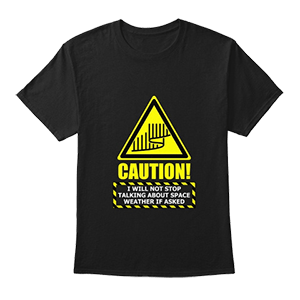Viewing archive of Monday, 4 December 2006
Solar activity report
Any mentioned solar flare in this report has a scaling factor applied by the Space Weather Prediction Center (SWPC). Because of the SWPC scaling factor, solar flares are reported as 42% smaller than for the science quality data. The scaling factor has been removed from our archived solar flare data to reflect the true physical units.
Report of Solar-Geophysical Activity 2006 Dec 04 2204 UTCPrepared by the NOAA © SWPC and processed by SpaceWeatherLive.com
Joint USAF/NOAA Report of Solar and Geophysical Activity
SDF Number 338 Issued at 2200Z on 04 Dec 2006IA. Analysis of Solar Active Regions and Activity from 03-2100Z to 04-2100Z
Solar activity was low. An active region rotating onto
the east limb (S06) produced eight C-class flares during the past 24
hours. The largest of these was a C4 flare at 04/1439Z. Region 926
(S10W43) has decayed since yesterday and is now a Beta magnetic
group. New Region 929 (N02E67) is classified as a Bxo-Beta group.
IB. Solar Activity Forecast
Solar activity is expected to be low.
IIA. Geophysical Activity Summary 03-2100Z to 04-2100Z
The geomagnetic field was quiet.
IIB. Geophysical Activity Forecast
The geomagnetic field is
expected to be quiet on 5 December. Quiet to active conditions are
expected on 6 December, as a coronal hole rotates into a
geoeffective position. Expect active to minor storm conditions,
with possible major storm periods, on 7 December.
III. Event Probabilities 05 Dec to 07 Dec
| Class M | 10% | 10% | 10% |
| Class X | 01% | 01% | 01% |
| Proton | 01% | 01% | 01% |
| PCAF | Green | ||
IV. Penticton 10.7 cm Flux
Observed 04 Dec 092 Predicted 05 Dec-07 Dec 090/090/095 90 Day Mean 04 Dec 080
V. Geomagnetic A Indices
Observed Afr/Ap 03 Dec 002/003 Estimated Afr/Ap 04 Dec 002/005 Predicted Afr/Ap 05 Dec-07 Dec 005/005-010/010-025/030
VI. Geomagnetic Activity Probabilities 05 Dec to 07 Dec
| A. Middle Latitudes | |||
|---|---|---|---|
| Active | 15% | 25% | 40% |
| Minor storm | 05% | 10% | 25% |
| Major-severe storm | 01% | 01% | 10% |
| B. High Latitudes | |||
|---|---|---|---|
| Active | 15% | 25% | 45% |
| Minor storm | 05% | 15% | 30% |
| Major-severe storm | 01% | 05% | 15% |
All times in UTC
Latest news
Latest forum messages
AR 4000 29Filaments and prominences 670Ask your obscure/"stupid" space weather questions. 256IP cameras for sky surveillance 50Incoming & Unnumbered Active Regions 1553
More topicsSupport SpaceWeatherLive.com!
A lot of people come to SpaceWeatherLive to follow the Sun's activity or if there is aurora to be seen, but with more traffic comes higher server costs. Consider a donation if you enjoy SpaceWeatherLive so we can keep the website online!

Latest alerts
Friday, 21 February 2025
14:54 UTC - Solar flare
Moderate M1.41 flare
14:39 UTC - Radio Blackout
Minor R1 radio blackout in progress (≥M1 - current: M1.41)
12:33 UTC - Solar flare
Moderate M3.39 flare
12:18 UTC - Radio Blackout
Minor R1 radio blackout in progress (≥M1 - current: M3.39)
Thursday, 20 February 2025
09:15 UTC - 10cm Radio Burst
Begin Time: 20/02/2025 04:44 UTC Maximum Time: 20/02/2025 04:44 UTC Duration: 1 minutes. Peak flux: 200 sfu
Space weather facts
| Last X-flare | 2025/01/04 | X1.85 |
| Last M-flare | 2025/02/21 | M1.4 |
| Last geomagnetic storm | 2025/02/19 | Kp5 (G1) |
| Spotless days | |
|---|---|
| Last spotless day | 2022/06/08 |
| Monthly mean Sunspot Number | |
|---|---|
| January 2025 | 137 -17.5 |
| February 2025 | 151.4 +14.4 |
| Last 30 days | 149 -14 |




